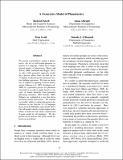| dc.contributor.author | Futrell, Richard Landy Jones | |
| dc.contributor.author | Albright, Adam | |
| dc.contributor.author | Graff, Peter | |
| dc.contributor.author | O’Donnell, Timothy J. | |
| dc.date.accessioned | 2020-11-18T22:54:02Z | |
| dc.date.available | 2020-11-18T22:54:02Z | |
| dc.date.issued | 2017-12 | |
| dc.identifier.issn | 2307-387X | |
| dc.identifier.uri | https://hdl.handle.net/1721.1/128532 | |
| dc.description.abstract | We present a probabilistic model of phonotactics, the set of well-formed phoneme sequences in a language. Unlike most computational models of phonotactics (Hayes and Wilson, 2008; Goldsmith and Riggle, 2012), we take a fully generative approach, modeling a process where forms are built up out of subparts by phonologically-informed structure building operations. We learn an inventory of subparts by applying stochastic memoization (Johnson et al., 2007; Goodman et al., 2008) to a generative process for phonemes structured as an and-or graph, based on concepts of feature hierarchy from generative phonology (Clements, 1985; Dresher, 2009). Subparts are combined in a way that allows tier-based feature interactions. We evaluate our models’ ability to capture phonotactic distributions in the lexicons of 14 languages drawn from the WOLEX corpus (Graff, 2012). Our full model robustly assigns higher probabilities to held-out forms than a sophisticated N-gram model for all languages. We also present novel analyses that probe model behavior in more detail. | en_US |
| dc.description.sponsorship | National Science Foundation (Grant 1551543) | en_US |
| dc.language.iso | en | |
| dc.publisher | MIT Press | en_US |
| dc.relation.isversionof | http://dx.doi.org/10.1162/tacl_a_00047 | en_US |
| dc.rights | Creative Commons Attribution 4.0 International license | en_US |
| dc.rights.uri | https://creativecommons.org/licenses/by/4.0/ | en_US |
| dc.source | MIT Press | en_US |
| dc.title | A Generative Model of Phonotactics | en_US |
| dc.type | Article | en_US |
| dc.identifier.citation | Futrell, Richard et al. "A Generative Model of Phonotactics." Transactions of the Association for Computational Linguistics 5 (December 2017): 73-86 © 2017 Association for Computational Linguistics | en_US |
| dc.contributor.department | Massachusetts Institute of Technology. Department of Brain and Cognitive Sciences | en_US |
| dc.contributor.department | Massachusetts Institute of Technology. Department of Linguistics and Philosophy | en_US |
| dc.relation.journal | Transactions of the Association for Computational Linguistics | en_US |
| dc.eprint.version | Final published version | en_US |
| dc.type.uri | http://purl.org/eprint/type/JournalArticle | en_US |
| eprint.status | http://purl.org/eprint/status/PeerReviewed | en_US |
| dc.date.updated | 2019-09-25T17:19:31Z | |
| dspace.date.submission | 2019-09-25T17:19:32Z | |
| mit.journal.volume | 5 | en_US |
| mit.metadata.status | Complete | |
